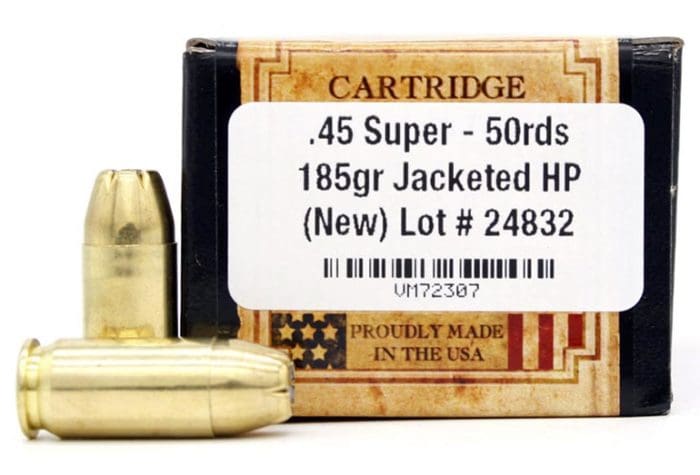The 10mm Auto round is a sure ticket to a superiority complex for the handgun owner. It’s sort of like how a person buys an Audi or a BMW and all of a sudden they’re too good for anyone, despite still barely being able to find their posterior with both hands and a road map.
We probably all know a person like that. If you think “Hey, I drive an Audi,” then YOU may be that person.
Anyhow, the thing is, if you want a big bore auto round with MORE POWAH, then you’re better off with .45 Super. In fact, the .45 Super arguably should have superseded the .45 ACP, but has unfortunately been relegated to niche status, basically popular only with pin shooters and a maybe a few handgun hunters.
So, if you want to get in the same league as Ol’ Death And Destruction (at least according to the 10mm guys) you might look into a .45 Super conversion. You get basically the same performance, but with some benefits that 10mm shooters don’t enjoy.
The standard 10mm load is a 180-grain bullet that achieves muzzle velocity in the neighborhood of 1200 fps to 1300 fps with muzzle energy around 700 ft-lbs, but generates chamber pressure around 33,000 psi.
Since .45 Super uses the same .452-in projectiles as .45 ACP and .45 Colt, a 185-grain projectile is more common for that chambering. A 185-grain .45 Super usually does basically the same; 1300 fps and just under 700 ft-lbs of energy. However, .45 Super generates chamber pressures more like 28,000 psi.
So, basically, you generate the same numbers but with a bit less pressure and reduced stress on the gun.
Additionally, the .45 Super can use heavier projectiles, up to at least 255-grain, though handloaders have found it can even take 300gr hardcast bullets with great care in loading.
Your range time can also be a lot less expensive. Your garden variety box of 50 10mm cartridges is usually $25 or more, though you can certainly find some deals out there. The thing about .45 Super is that the case has the exact same dimensions as .45 ACP though the case walls are thicker. Thus, a .45 Super handgun will also chamber, fire and cycle with .45 ACP, which is about $5 to $10 cheaper per box of factory ammo.
You may need to swap in a lower-power recoil spring for .45 ACP, but they’re cheap.
The full-power loads will cost you (only a few companies make .45 Super, and it’s expensive) but range time doesn’t have to be. You can even buy .45 ACP +P in a pinch as a carry load, since a .45 Super handgun won’t have any issues.
Some pistols rated for .45 ACP +P can run .45 Super straight from the factory, with maybe only a new spring kit. 1911 pistols are easily converted, needing only a spring kit and a flat-bottom firing pin stop. In some cases, a .45 Super barrel will be necessary as the case must be well supported when chambered.
That said, if you want serious power out of a semi-auto, the .45 Super is one of the better ways to go about getting it. It’s sort of a shame the caliber isn’t more popular. Unfortunately, the round never found adoption by law enforcement or anywhere other than for sport shooting.
Ever think about a .45 Super conversion? Anyone out there actually have one?
Sam Hoober is a contributing editor for Alien Gear Holsters and Bigfoot Gun Belts. He also contributes regularly to USA Carry and the Daily Caller.
